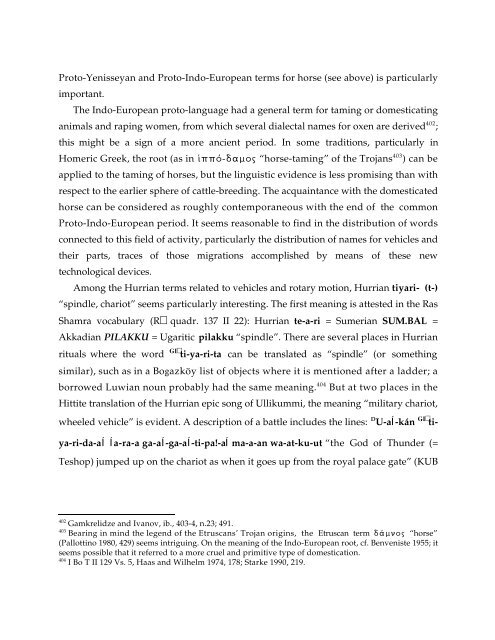Comparative Notes on Hurro-Urartian, Northern Caucasian
Comparative Notes on Hurro-Urartian, Northern Caucasian
Comparative Notes on Hurro-Urartian, Northern Caucasian
Create successful ePaper yourself
Turn your PDF publications into a flip-book with our unique Google optimized e-Paper software.
Proto-Yenisseyan and Proto-Indo-European terms for horse (see above) is particularly<br />
important.<br />
The Indo-European proto-language had a general term for taming or domesticating<br />
animals and raping women, from which several dialectal names for oxen are derived 402 ;<br />
this might be a sign of a more ancient period. In some traditi<strong>on</strong>s, particularly in<br />
Homeric Greek, the root (as in flppÒ-damow “horse-taming” of the Trojans 403 ) can be<br />
applied to the taming of horses, but the linguistic evidence is less promising than with<br />
respect to the earlier sphere of cattle-breeding. The acquaintance with the domesticated<br />
horse can be c<strong>on</strong>sidered as roughly c<strong>on</strong>temporaneous with the end of the comm<strong>on</strong><br />
Proto-Indo-European period. It seems reas<strong>on</strong>able to find in the distributi<strong>on</strong> of words<br />
c<strong>on</strong>nected to this field of activity, particularly the distributi<strong>on</strong> of names for vehicles and<br />
their parts, traces of those migrati<strong>on</strong>s accomplished by means of these new<br />
technological devices.<br />
Am<strong>on</strong>g the Hurrian terms related to vehicles and rotary moti<strong>on</strong>, Hurrian tiyari- (t-)<br />
“spindle, chariot” seems particularly interesting. The first meaning is attested in the Ras<br />
Shamra vocabulary (R quadr. 137 II 22): Hurrian te-a-ri = Sumerian SUM.BAL =<br />
Akkadian PILAKKU = Ugaritic pilakku “spindle”. There are several places in Hurrian<br />
rituals where the word ti-ya-ri-ta can be translated as “spindle” (or something<br />
similar), such as in a Bo azköy list of objects where it is menti<strong>on</strong>ed after a ladder; a<br />
borrowed Luwian noun probably had the same meaning. 404 But at two places in the<br />
Hittite translati<strong>on</strong> of the Hurrian epic s<strong>on</strong>g of Ullikummi, the meaning “military chariot,<br />
wheeled vehicle” is evident. A descripti<strong>on</strong> of a battle includes the lines: D U-aÍ-kán ti-<br />
ya-ri-da-aÍ Ía-ra-a ga-aÍ-ga-aÍ-ti-pa!-aÍ ma-a-an wa-at-ku-ut “the God of Thunder (=<br />
Teshop) jumped up <strong>on</strong> the chariot as when it goes up from the royal palace gate” (KUB<br />
402 Gamkrelidze and Ivanov, ib., 403-4, n.23; 491.<br />
403 Bearing in mind the legend of the Etruscans’ Trojan origins, the Etruscan term dãmnow “horse”<br />
(Pallottino 1980, 429) seems intriguing. On the meaning of the Indo-European root, cf. Benveniste 1955; it<br />
seems possible that it referred to a more cruel and primitive type of domesticati<strong>on</strong>.<br />
404 I Bo T II 129 Vs. 5, Haas and Wilhelm 1974, 178; Starke 1990, 219.





